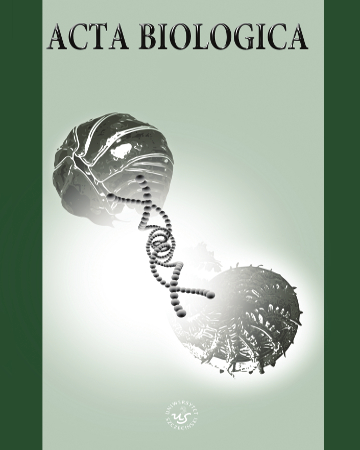
ISSN: 2450-8330
OAI
DOI: 10.18276/ab.2017.24-09



Liste der Ausgaben /
No. 24
Body satisfaction versus anthropometric and lifestyle characteristics in secondary school youth in a three-year study
(Zadowolenie z własnej sylwetki wobec charakterystyki antropometrycznej i trybu życia u młodzieży licealnej w ciągu trzech lat badań)
| Autoren: |
Ewa
Rębacz-Maron
University of Szczecin, Department of Vertebrate Zoology and Anthropology, Institute for Research on Biodiversity, Faculty of Biology Patryk Lisiecki Student of biology at the University of Szczecin |
| Schlüsselbegriffe: | zadowolenie z własnej sylwetki antropometria młodzież licealna tryb życia nawyki żywieniowe zachowania żywieniowe |
| Veröffentlichungsdatum der gesamten Ausgabe: | 2017 |
| Seitenanzahl: | 11 (89-99) |
Abstract
Tło. Współczesna moda na szczupłą sylwetkę przenika do wszystkich grup społecznych
w każdym wieku. Monitorowanie zachowań zdrowotnych i żywieniowych wśród młodzieży
jest niezbędne, aby przeciwdziałać złym nawykom żywieniowym.
Cel. Zbadanie zadowolenia z własnej sylwetki przy uwzględnieniu antropometrii i aktywności
ruchowej u młodzieży licealnej w ciągu trzech lat badań.
Materiał & Metoda. Badania antropologiczne u tej samej młodzieży licealnej zostały wykonane
w 2014, 2015, 2016 roku – zawsze we wrześniu. Zmierzono: masę ciała, wysokość ciała
(B-v), obwód pasa i bioder. Wyliczono wskaźniki somatyczne: BMI, WHR, wskaźnik Rohrera.
Pytania ankietowe dotyczyły liczby godzin aktywności fizycznej w tygodniu, jak długo trenuje
uczeń podaną dyscyplinę sportową, ocena zadowolenia z własnej sylwetki, wywiad dotyczący
nawyków żywieniowych.
Wyniki. U dziewcząt i chłopców intensywność ćwiczeń fizycznych z roku na rok spadała.
Być może dlatego, że młodzież się poznała po pierwszym roku i już nie chciała pracować nad
sylwetką (dla większej atrakcyjności). Aż 56% dziewcząt nie było zadowolonych w I klasie ze
swojej sylwetki i 71% chłopców. W dwóch kolejnych latach nauki odsetek niezadowolonych
obniżył się u obu płci.
Podsumowanie. Konieczne jest wdrażanie programów prozdrowotnych, aby młodzi ludzie
poznali zasady żywieniowe i nie eksperymentowali z przesadnym kontrolowaniem masy ciała.
herunterladen
Artikeldatei
Bibliographie
| 1. | Diedrichs, P.C., Lee, Ch. (2010). GI Joe Or Average Joe? The impact of average-size and muscular male fashion models on men’s and women’s body image and advertisement effectiveness. Body Image, 3 (7), 218–226. DOI: 10.1016/j.bodyim.2010.03.004. |
| 2. | Drozdowski, Z. (1998). Antropometria w wychowaniu fizycznym. Poznań: AWF. |
| 3. | Frederick, D.A., Buchanan, G.M., Sadehgi-Azar, L., Peplau, L.A., Haselton, M.G., Berezovskaya, A. Lipin¬ski, R.E. (2007). Desiring the muscular ideal: Men’s body satisfaction in the United States, Ukraine and Ghana. Psychology of Men & Masculinity, 8, 103–117. DOI: 10.1037/1524-9220.8.2.103. |
| 4. | Kakeshita, I.S., Almeida, S.S. (2006). Relationship betwen body mass index and self-perception among university students. Rev Saúde Pública, 3 (40). |
| 5. | Levitsky, D.A. (2005). The non-regulation of food intake in humans: hope for reversing the epidemic of obesity. Physiol Behav, 5 (86), 623–632. |
| 6. | Lipowska, M., Lipowski, M. (2006). Ocena własnej atrakcyjności przez kobiety w różnym wieku. In: A. Chybicka, M. Kaźmierczak (eds.), Kobieta w kulturze – kultura w kobiecie (pp. 385–402). Kraków: Oficyna Wydawnicza Impuls. |
| 7. | Lipowski, M., Lipowska, M. (2015). Poziom narcyzmu jako moderator relacji pomiędzy obiektywnymi wymiarami ciała a stosunkiem do własnej cielesności młodych mężczyzn. Polskie Forum Psychologiczne, 1 (20), 31–46. |
| 8. | Łaska-Mierzejewska, T. (1997). Ćwiczenia z antropologii. Warszawa: AWF. |
| 9. | McCreary, D.R., Saucier, D.M. (2009). Drive for muscularity, body comparison and social physique anxiety in men and women. Body Image, 1 (6),24–30. |
| 10. | McGuire, M.T. (1999). What predicts weight regain in a group of successful weight losers? J Consult Clin Psychol, 67, 177–185. |
| 11. | Myszkowska-Ryciak, J., Gago, E., Harton, A. (2015). Wiedza żywieniowa oraz postrzeganie własnej masy ciała przez nastoletnie dziewczęta. In: A. Wolska-Adamczyk (ed.), Znaczenie racjonalnego żywienia w edukacji zdrowotnej. Warszawa: WSIiZ. |
| 12. | Patton, G.C., Selzer, R., Coffey, C., Carlin, J.B., Wolfe, R. (1999). Onset of adolescent eating disorders: population based cohort study over 3 years. Br. Med. J., 318 (7186), 765–768. |
| 13. | Physical status: the Use and Interpretation of Anthropometry (1995). Report of a WHO expert committee. WHO Tech Rep Ser, 854, 1–452. |
| 14. | Romanowska-Tołłoczko, A., Kałwa, M. (2014). Oddziaływania psychologiczne w kompleksowej terapii nadwagi. Probl Hig Epidemiol, 2 (95), 209–214. |
| 15. | Sandler, R., Slemenda, C.W., LaPorte, R.E., et al. (1985). Postmenopausal bone density and milk consump¬tion in childhood and adolescence. Am J Clin Nutr, 42, 270–274. |
| 16. | Schneider, N., Frieler, K., Pfeiffer, E., Lehmkuhl, U., Salbach-Andrae, H. (2009). Comparison of body size estimation with different types of eating disorders. Eat Disord Rev, 17, 468–475. |
| 17. | Sorensen, T., Stunkard, A., Teasdale, T., Higgins, M. (1983). The accuracy of reports of weight: children’s recall of their parents weights 15 y earlier. Int J Obs, 7, 115–122. |
| 18. | Szponar, L., Respondek, W. (2000). Choroby pierwotne na tle niedoborów żywieniowych. Żywienie czło¬wieka zdrowego i chorego. Warszawa: Wydawnictwo Naukowe PWN. |
| 19. | Tanofsky-Kraff, M., Cohen, M.L., Yanovsky, S.Z., Cox, Ch., Heim, K.R., Keil, M., Reynolds, J.C., Yano-vski, A. (2006). A prospective study of psychological predictors of body fat gain among children at high risk for adult obesity. Pediatrics, 117, 1203–1209. |
| 20. | The Surgeon General’s Report on Nutrition and Health (1988). Washington, DC: US Public Health Service, Office of the Surgeon General. |
| 21. | Tylka, T.L. (2011). Refinement of the tripartite influence model for men: Dual body image pathways to body change behaviors. Body Image, 3 (8), 199–207. |
| 22. | Wojtyła-Buciora, P., Marcinkowski, J.T. (2010). Sposób żywienia, zadowolenie z własnego wyglądu i wyobrażenie o idealnej sylwetce młodzieży licealnej. Probl Hig Epidemiol, 2 (91), 227–232. |
| 23. | Woynarowska, B. (2003). Środowisko psychospołeczne szkoły i przystosowanie szkolne a zdrowie i zachowanie zdrowotne uczniów w Polsce. Raport z badań. Warszawa. |